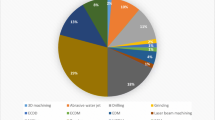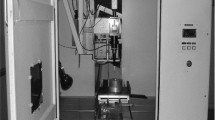Abstract
This paper presents a new integrated methodology based on evolutionary algorithms (EAs) to model and optimize the laser beam cutting process. The proposed study is divided into two parts. Firstly, genetic programming (GP) approach is used for empirical modelling of kerf width (Kw) and material removal rate (MRR) which are the important performance measures of the laser beam cutting process. GP, being an extension of the more familiar genetic algorithms, recently has evolved as a powerful optimization tool for nonlinear modelling resulting in credible and accurate models. Design of experiments is used to conduct the experiments. Four prominent variables such as pulse frequency, pulse width, cutting speed and pulse energy are taken into consideration. The developed models are used to study the effect of laser cutting parameters on the chosen process performances. As the output parameters Kw and MRR are mutually conflicting in nature, in the second part of the study, they are simultaneously optimized by using a multi-objective evolutionary algorithm called non-dominated sorting genetic algorithm II. The Pareto optimal solutions of parameter settings have been reported that provide the decision maker an elaborate picture for making the optimal decisions. The work presents a full-fledged evolutionary approach for optimization of the process.
Similar content being viewed by others
References
Walsh RA, Cormier DR (2006) McGraw-Hill machining and metalworking handbook, 3rd edn. McGraw-Hill, New York
Prasad GVS, Siores E, Wong WCK (1998) Laser cutting of metallic coated sheet steels. J Mater Process Technol 74:234–242
Dubey AK, Yadava V (2008) Laser beam machining—a review. Int J Mach Tool Manuf 48:609–628
Yousef BF, George K, Knopf, Evgueni V, Bordatchev, Suwas K, Nikumb (2003) Neural network modeling and analysis of the material removal process during laser machining. Int J Adv Manuf Technol 22:41–53. doi:10.1007/s00170-002-1441-9
Li C-H, Tsaia M-J, Yang C-D (2007) Study of optimal laser parameters for cutting QFN packages by Taguchi’s matrix method. Optic Laser Tech 39:786–795
Jimin C, Yang J, Zhang S, Zuo T, Guo D (2007) Parameter optimization of non-vertical laser cutting. Int J Adv Manuf Technol 33:469–473. doi:10.1007/s00170-006-0489-3
Dhara SK, Kuar AS, Mitra S (2008) An artificial neural network approach on parametric optimization of laser micro-machining of die-steel. Int J Adv Manuf Technol 39:39–46. doi:10.1007/s00170-007-1199-1
Dubey AK, Yadava V (2008) Multi-objective optimisation of laser beam cutting process. Optic Laser Tech 40(3):562–570
Avanish Kumar D, Vinod Y (2008) Optimization of kerf quality during pulsed laser cutting of aluminium alloy sheet. J Mater Process Technol 204(11):412–418
Ming-Jong T, Chen-Hao Li, Cheng-Che C (2008) Optimal laser-cutting parameters for QFN packages by utilizing artificial neural networks and genetic algorithm. J Mater Process Technol 208(1–3):270–283
Sardiñas RQ, Santana MR, Brindis EA (2006) Genetic algorithm based multi-objective optimization of cutting parameters in turning processes. Eng Appl Artif Intell 19:127–133
Deb K, Pratap A, Agarwal S, Meyarivan T (2002) A fast and elitist multiobjective genetic algorithm: NSGA-II. IEEE Trans Evol Comput 6(2):182–197
Koza JR (1992) Genetic programming: on the programming of computers by means of natural selection. MIT Press, Cambridge
Goldberg DE (1989) Genetic algorithms in search, optimisation, and machine learning. Addison-Wesley, Reading, MA
Dolinsky JU, Jenkinson ID, Colquhoun GJ (2007) Application of genetic programming to the calibration of industrial robots. Comput Ind 58:255–264
Zhang L, Jack LB, Nandi AK (2005) Fault detection using genetic programming. Mech Syst Signal Proc 19(2):271–289
Ashour AF, Alvarez LF, Toropov VV (2003) Empirical modelling of shear strength of RC deep beams by genetic programming. Comput Struct 81(5):331–338
Kondayya D, Gopalakrishna A (2010) An integrated evolutionary approach for modelling and optimization of wire electrical discharge machining. Proc IME B J Eng Manufact 225:549–567. doi:10.1243/09544054JEM1975
Poli R, Langdon WB, McPhee NF (2010) A field guide to genetic programming. http://www.gp-field-guide.org.uk. Accessed Dec 2010
Konak A, Coit DW, Smith AE (2006) Multi-objective optimization using genetic algorithms: a tutorial. Reliab Eng Syst Saf 91(9):992–1007
Deb, K.; Agarwal, S.; Pratap, A.; Meyarivan, T (2000) A fast elitist nondominated sorting genetic algorithm for multiobjective optimization: NSGA II. In Proceedings of the Parallel Problem Solving from Nature VI (PPSN-VI), Springer: NY, 849–858
Deb K, Pratap A, Agarwal S, Meyarivan T (2002) A fast and elitist multiobjective genetic algorithm: NSGA-II. IEEE Trans Evol Comput 6(2):182–197
Banzhaf W, Nordin P, Keller R, Francone F (1998) Genetic programming: an introduction. Morgan Kaufmann, San Francisco
Koza JR, Bennett FH III, Andre D, Martin A, Keane (1999) Genetic programming III: Darwinian invention and problem solving. Morgan Kaufmann, San Francisco
Author information
Authors and Affiliations
Corresponding author
Rights and permissions
About this article
Cite this article
Kondayya, D., Gopala Krishna, A. An integrated evolutionary approach for modelling and optimization of laser beam cutting process. Int J Adv Manuf Technol 65, 259–274 (2013). https://doi.org/10.1007/s00170-012-4165-5
Received:
Accepted:
Published:
Issue Date:
DOI: https://doi.org/10.1007/s00170-012-4165-5




